DODGE DURANGO 2013 3.G User Guide
Manufacturer: DODGE, Model Year: 2013, Model line: DURANGO, Model: DODGE DURANGO 2013 3.GPages: 140, PDF Size: 4.38 MB
Page 111 of 140
WARNING!
• When temperatures are below the freezing point, electrolyte in a discharged batterymay freeze. Do not attempt jump-starting because the battery could rupture or
explode and cause personal injury. Battery temperature must be brought above the
freezing point before attempting a jump-start.
• Take care to avoid the radiator cooling fan whenever the hood is raised. It can start anytime the ignition switch is on. You can be injured by moving fan blades.
• Remove any metal jewelry, such as watch bands or bracelets, that might make an
inadvertent electrical contact. You could be severely injured.
• Batteries contain sulfuric acid that can burn your skin or eyes and generate hydrogen
gas which is flammable and explosive. Keep open flames or sparks away from the
battery.
• Do not allow vehicles to touch each other as this could establish a ground connection
and personal injury could result.
• Failure to follow this procedure could result in personal injury or property damage
due to battery explosion.
• Do not connect the cable to the negative post (-) of the discharged battery. The resulting electrical spark could cause the battery to explode and could result in
personal injury.
EMERGENCY TOW HOOKS
• If your vehicle is equipped with tow hooks, they are mounted in the front.
NOTE:
For off-road recovery, it is recommended to use both of the front tow hooks to minimize the
risk of damage to the vehicle.
CAUTION!
Tow hooks are for emergency use only, to rescue a vehicle stranded off-road. Do not use
tow hooks for tow truck hookup or highway towing. You could damage your vehicle. Tow
straps are recommended when towing the vehicle; chains may cause vehicle damage.
WARNING!
• Chains are not recommended for freeing a stuck vehicle. Chains may break, causingserious injury or death.
• Stand clear of vehicles when pulling with tow hooks. Tow straps may become
disengaged, causing serious injury.
WHAT TO DO IN EMERGENCIES
109
Page 112 of 140

SHIFT LEVER OVERRIDE
•If a malfunction occurs and the shift lever
cannot be moved out of the PARK position,
you can use the following procedure to
temporarily move the shift lever:
• To access the shift lever override, re-
move the rubber cupholder liner to the
right of the shift lever.
• Firmly set the parking brake.
• Turn the ignition switch to the ACC or ON position without starting the engine.
• Press and maintain firm pressure on the brake pedal.
• Using a screwdriver or similar tool, press and hold the override tab through
the access port on the center console.
• Move the shift lever into the NEUTRAL position.
• The vehicle may then be started in NEUTRAL.
• Reinstall the override cover.
WHAT TO DO IN EMERGENCIES
110
Page 113 of 140

TOWING A DISABLED VEHICLE
Towing Condition Wheels OFF theGround RWD Models
AWD Models
Flat Tow NONE• Transmission in
NEUTRAL
• 30 mph (48 km/h)
• 15 miles (24 km) maxdistance • Transmission in
PARK
• T/case in NEUTRAL
• To w i n Forward direction
Wheel Lift or Dolly Tow Front
Rear OK
NO
Flatbed ALL BEST METHOD BEST METHOD
WHAT TO DO IN EMERGENCIES
111
Page 114 of 140
FREEING A STUCK VEHICLE
• If your vehicle becomes stuck in mud, sand or snow, it can often be moved by a rockingmotion. Turn your steering wheel right and left to clear the area around the front wheels.
Then, move the shift lever back and forth between REVERSE and DRIVE. Using minimal
accelerator pedal pressure to maintain the rocking motion, without spinning the wheels,
is most effective.
• Allow the engine to idle with the transmission shift lever in NEUTRAL for at least one minute after every five rocking-motion cycles. This will minimize overheating and reduce
the risk of transmission failure during prolonged efforts to free a stuck vehicle.
NOTE:
If your vehicle is equipped with Electronic Stability Control (ESC) then press the "ESC Off"
switch, to place the Electronic Stability Control (ESC) system in "Partial Off" mode, before
rocking the vehicle.
CAUTION!
Revving the engine or spinning the wheels too fast may lead to transmission overheating
and failure. It can also damage the tires. Do not spin the wheels above 30 mph (48 km/h)
while in gear (no transmission shifting occurring).
WARNING!
Fast spinning tires can be dangerous. Forces generated by excessive wheel speeds may
cause tire damage or failure. A tire could explode and injure someone. Do not spin your
vehicle's wheels faster than 30 mph (48 km/h) when you are stuck. Do not let anyone
near a spinning wheel, no matter what the speed.
WHAT TO DO IN EMERGENCIES
112
Page 115 of 140
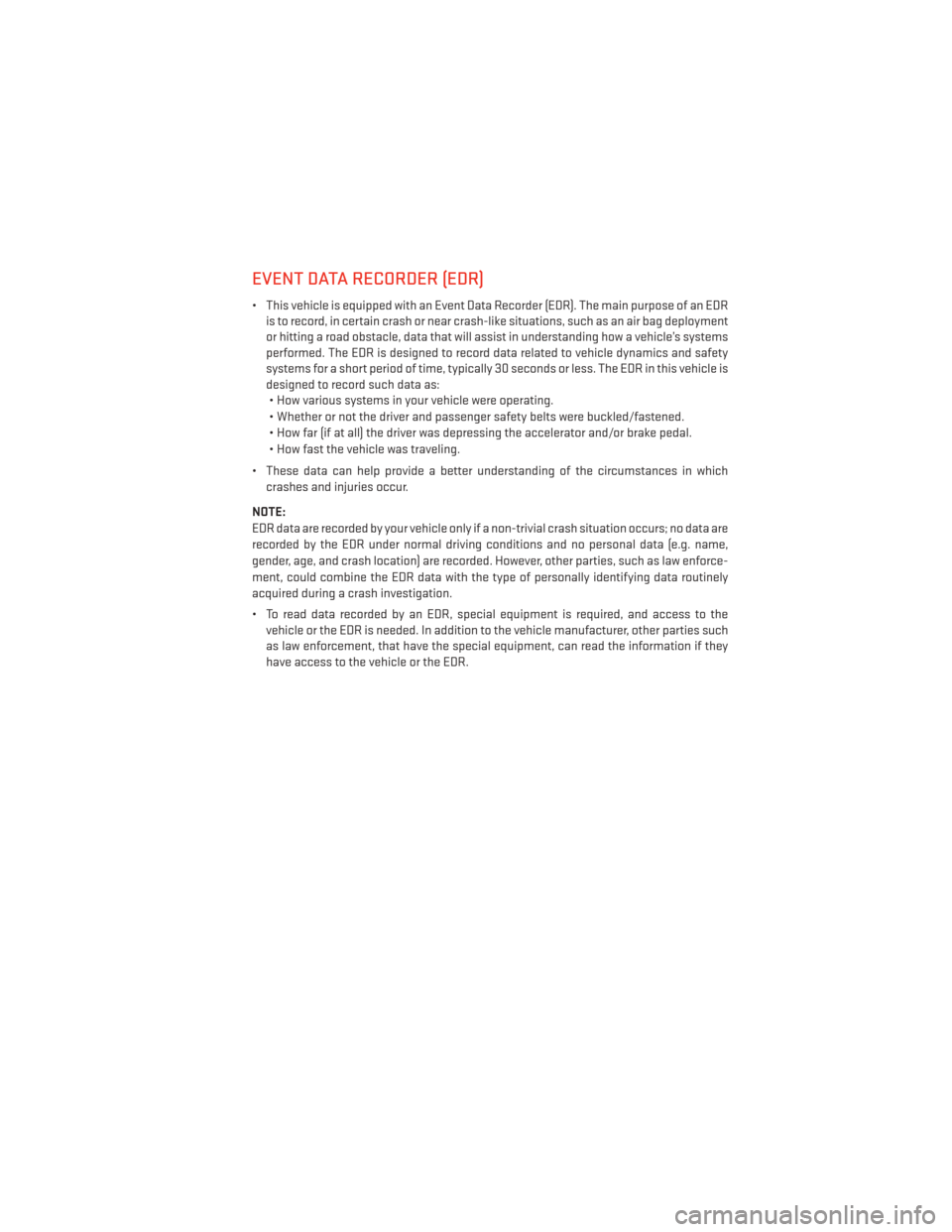
EVENT DATA RECORDER (EDR)
• This vehicle is equipped with an Event Data Recorder (EDR). The main purpose of an EDRis to record, in certain crash or near crash-like situations, such as an air bag deployment
or hitting a road obstacle, data that will assist in understanding how a vehicle’s systems
performed. The EDR is designed to record data related to vehicle dynamics and safety
systems for a short period of time, typically 30 seconds or less. The EDR in this vehicle is
designed to record such data as:• How various systems in your vehicle were operating.
• Whether or not the driver and passenger safety belts were buckled/fastened.
• How far (if at all) the driver was depressing the accelerator and/or brake pedal.
• How fast the vehicle was traveling.
• These data can help provide a better understanding of the circumstances in which crashes and injuries occur.
NOTE:
EDR data are recorded by your vehicle only if a non-trivial crash situation occurs; no data are
recorded by the EDR under normal driving conditions and no personal data (e.g. name,
gender, age, and crash location) are recorded. However, other parties, such as law enforce-
ment, could combine the EDR data with the type of personally identifying data routinely
acquired during a crash investigation.
• To read data recorded by an EDR, special equipment is required, and access to the vehicle or the EDR is needed. In addition to the vehicle manufacturer, other parties such
as law enforcement, that have the special equipment, can read the information if they
have access to the vehicle or the EDR.
WHAT TO DO IN EMERGENCIES
113
Page 116 of 140
OPENING THE HOOD
•Pull the hood release lever located below
the steering wheel at the base of the instru-
ment panel.
•Reach into the opening beneath the center
of the hood and move the safety latch lever
while lifting the hood at the same time.
WARNING!
Be sure the hood is fully latched before driving your vehicle. If the hood is not fully
latched, it could open when the vehicle is in motion and block your vision. Failure to
follow this warning could result in serious injury or death.
FUEL DOOR RELEASE
• The fuel door release button is located on the instrument panel below the headlight
switch.
• Push the button once and release to open the fuel door.
MAINTAINING YOUR VEHICLE
114
Page 117 of 140
Fuel Door Emergency Release
• To manually open the fuel door, removethe storage bin located in the left rear
cargo area.
•
Pull the release cable located in the storage
bin opening.
MAINTAINING YOUR VEHICLE
115
Page 118 of 140

ENGINE COMPARTMENT3.6L ENGINE
MAINTAINING YOUR VEHICLE
116
Page 119 of 140
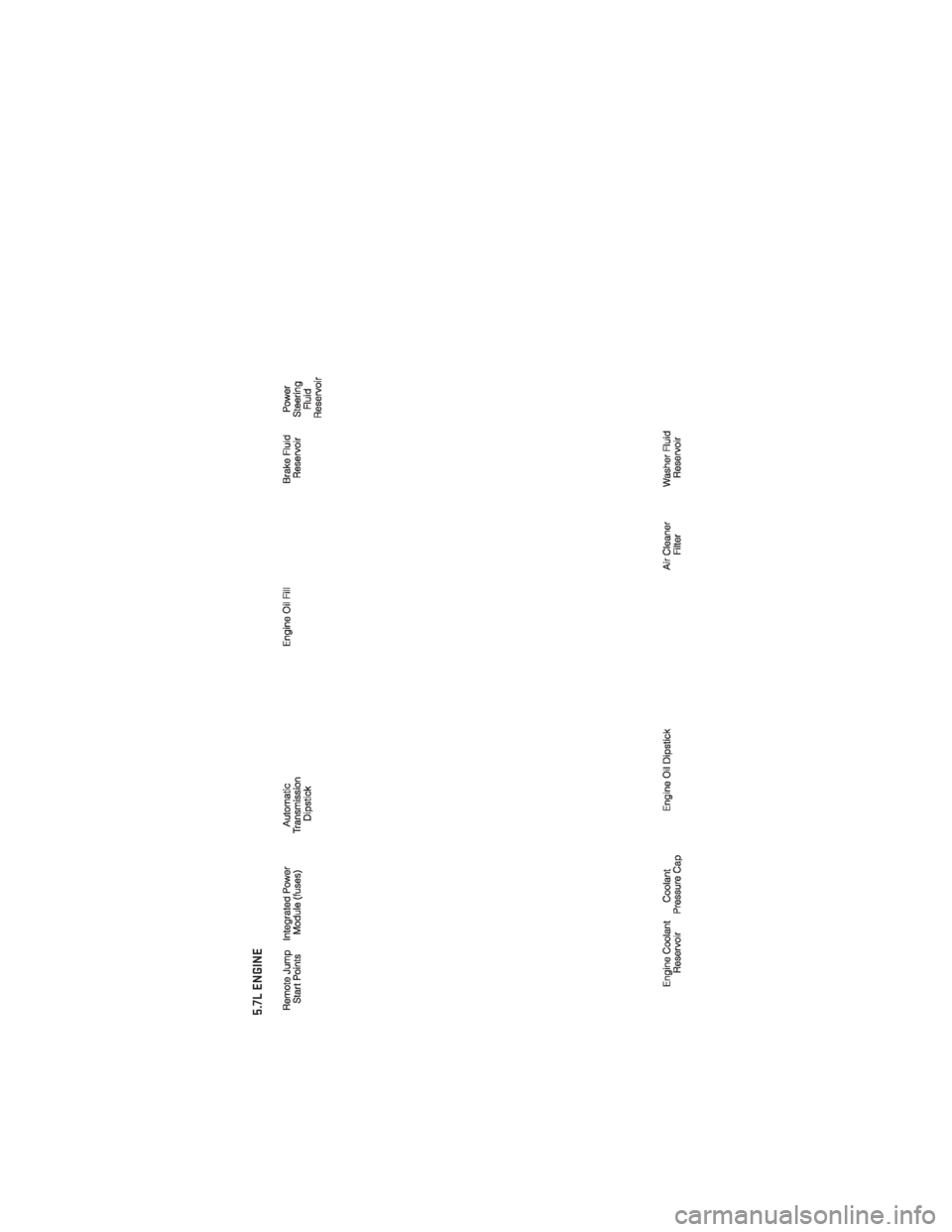
5.7L ENGINE
MAINTAINING YOUR VEHICLE
117
Page 120 of 140
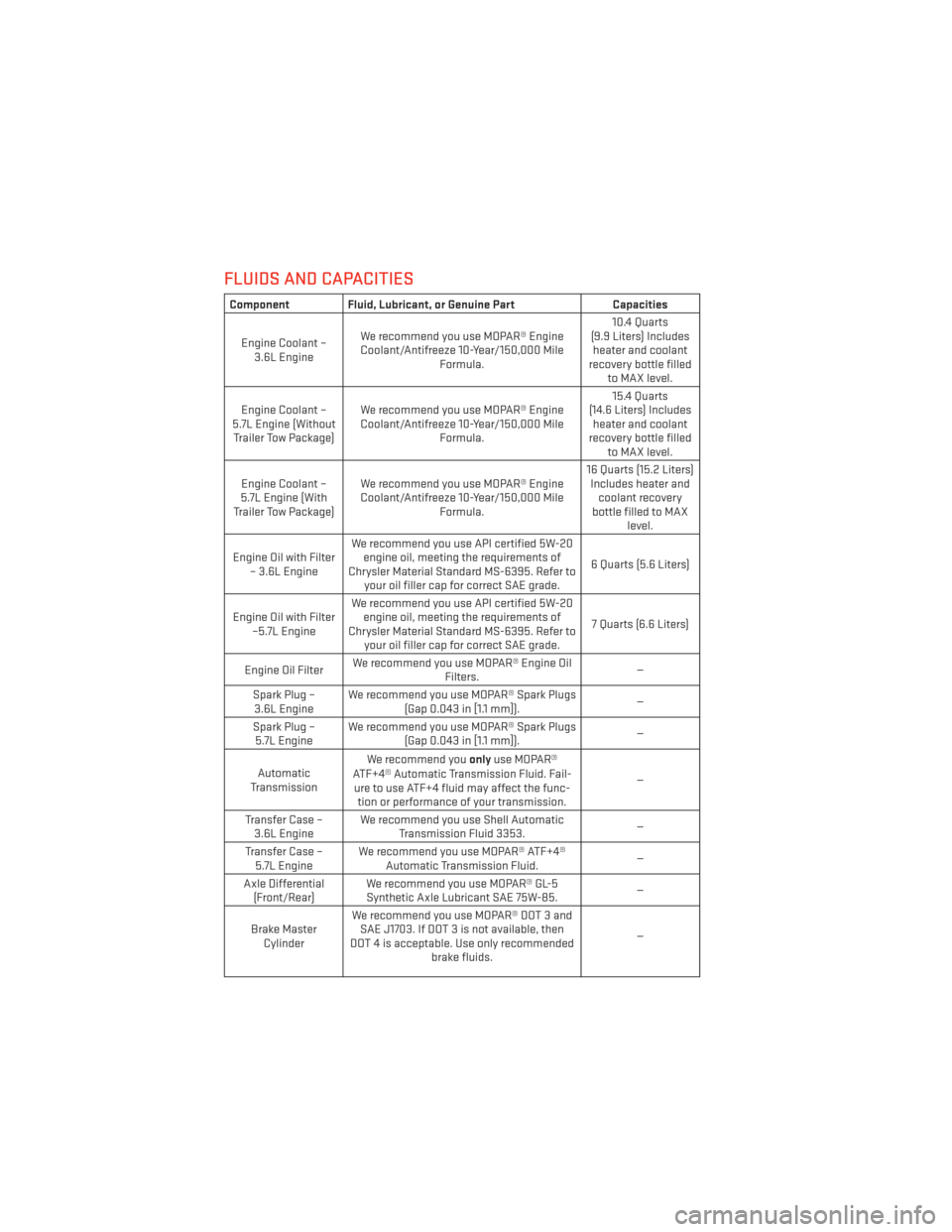
FLUIDS AND CAPACITIES
Component Fluid, Lubricant, or Genuine PartCapacities
Engine Coolant – 3.6L Engine We recommend you use MOPAR® Engine
Coolant/Antifreeze 10-Year/150,000 Mile Formula. 10.4 Quarts
(9.9 Liters) Includes heater and coolant
recovery bottle filled to MAX level.
Engine Coolant –
5.7L Engine (Without Trailer Tow Package) We recommend you use MOPAR® Engine
Coolant/Antifreeze 10-Year/150,000 Mile Formula. 15.4 Quarts
(14.6 Liters) Includes heater and coolant
recovery bottle filled to MAX level.
Engine Coolant –
5.7L Engine (With
Trailer Tow Package) We recommend you use MOPAR® Engine
Coolant/Antifreeze 10-Year/150,000 Mile Formula. 16 Quarts (15.2 Liters)
Includes heater and coolant recovery
bottle filled to MAX level.
Engine Oil with Filter – 3.6L Engine We recommend you use API certified 5W-20
engine oil, meeting the requirements of
Chrysler Material Standard MS-6395. Refer to your oil filler cap for correct SAE grade. 6 Quarts (5.6 Liters)
Engine Oil with Filter –5.7L Engine We recommend you use API certified 5W-20
engine oil, meeting the requirements of
Chrysler Material Standard MS-6395. Refer to your oil filler cap for correct SAE grade. 7 Quarts (6.6 Liters)
Engine Oil Filter We recommend you use MOPAR® Engine Oil
Filters. —
Spark Plug – 3.6L Engine We recommend you use MOPAR® Spark Plugs
(Gap 0.043 in [1.1 mm]). —
Spark Plug – 5.7L Engine We recommend you use MOPAR® Spark Plugs
(Gap 0.043 in [1.1 mm]). —
Automatic
Transmission We recommend you
onlyuse MOPAR®
ATF+4® Automatic Transmission Fluid. Fail- ure to use ATF+4 fluid may affect the func- tion or performance of your transmission. —
Transfer Case – 3.6L Engine We recommend you use Shell Automatic
Transmission Fluid 3353. —
Transfer Case – 5.7L Engine We recommend you use MOPAR® ATF+4®
Automatic Transmission Fluid. —
Axle Differential (Front/Rear) We recommend you use MOPAR® GL-5
Synthetic Axle Lubricant SAE 75W-85. —
Brake Master Cylinder We recommend you use MOPAR® DOT 3 and
SAE J1703. If DOT 3 is not available, then
DOT 4 is acceptable. Use only recommended brake fluids. —
MAINTAINING YOUR VEHICLE
118